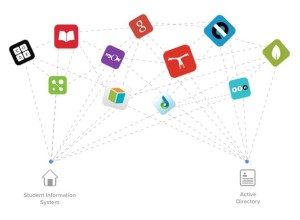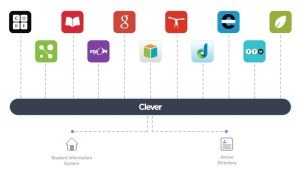How clever is Clever?

Clever's multi-sided data sharing and learning application platform for K12 school districts
Clever is a software company that enables K-12 districts to easily manage the process of sharing student information with application providers. The company is simplifying the data sharing process by enabling schools districts to use Clever as the single interface between the district’s student information system and all applications.
Currently, districts use student information systems to house their student data such as demographics, enrollment, performance, etc.. These  information systems are generally outdated, cumbersome to manage, and do not have robust API capabilities to facilitate easy data sharing between the enterprise system and other applications. Additionally, the district’s staff do not have the expertise or capacity to continually integrate and manage individual applications. Coupling these issues with the increasing adoption and efficacy of learning applications, districts have had to find manual system workarounds to facilitate data sharing between their information system and the applications that schools and teachers demand. This has led to manual, redundant, insecure, and unreliable data sharing between the application administrators, ie. teachers, principals, etc., and the application providers. This process has frustrated all parties: the district staff who have to manually extract, upload, and maintain data for each application, vendors because the data is often unreliable and out of date, parents because their student’s data is insecure, and students/teachers because they have to log onto each application separately and manage multiple logins and passwords. By identifying and servicing the pain points of all of these constituents, Clever has been able to build a successful multi-sided platform that has experience tremendous growth in just three years.
information systems are generally outdated, cumbersome to manage, and do not have robust API capabilities to facilitate easy data sharing between the enterprise system and other applications. Additionally, the district’s staff do not have the expertise or capacity to continually integrate and manage individual applications. Coupling these issues with the increasing adoption and efficacy of learning applications, districts have had to find manual system workarounds to facilitate data sharing between their information system and the applications that schools and teachers demand. This has led to manual, redundant, insecure, and unreliable data sharing between the application administrators, ie. teachers, principals, etc., and the application providers. This process has frustrated all parties: the district staff who have to manually extract, upload, and maintain data for each application, vendors because the data is often unreliable and out of date, parents because their student’s data is insecure, and students/teachers because they have to log onto each application separately and manage multiple logins and passwords. By identifying and servicing the pain points of all of these constituents, Clever has been able to build a successful multi-sided platform that has experience tremendous growth in just three years.
Clever’s solution is a multi-sided platform where districts, application providers, and application users interact. Clever integrates with the district’s student  information system where the relevant data fields are shared. This active data is then shared securely through the Clever platform with the chosen application providers. Once the applications are selected and the relevant information is shared, Clever acts as a single sign on solution for users of all applications. This passport function simplifies the user’s experience by allowing the students and teachers to seamlessly use the applications for instruction without disruption due to login issues. These features create a win-win-win for all parties.
information system where the relevant data fields are shared. This active data is then shared securely through the Clever platform with the chosen application providers. Once the applications are selected and the relevant information is shared, Clever acts as a single sign on solution for users of all applications. This passport function simplifies the user’s experience by allowing the students and teachers to seamlessly use the applications for instruction without disruption due to login issues. These features create a win-win-win for all parties.
Despite its clear benefits, Clever had to do a number of things right in order to achieve the scale it has today with adoption by 44,000 US schools, which is about one-third of the K12 schools in the US, and 200 application providers. In order to entice districts to adopt their service, they offer the software free of charge. This makes Clever’s value proposition almost irresistible for districts: it’s free, simplifies the lives of administrators, is secure, and allows districts to more quickly adopt the best applications for easy student use. Once the start-up was able to get districts to sign on, application providers were eager to integrate because it significantly simplified the process and reduced the cost of launching their application with each district and made their applications more effective by providing correct data. Once the platform began to gain traction, there were direct network effects, which benefited both parties. More application providers were eager to integrate with clever as more districts signed on and more districts wanted to adopt the product as more applications became available. Integration with Clever became a selling point for vendors and districts. Now, Clever is monetizing its platform by charging application vendors $5 to $25 per school per month.
Clever has been very successful but it must maintain the its current value proposition for all parties in order have continued success. If the per school charge for application vendors to use Clever becomes too high, the vendors may seek to collaborate and build a new platform to replace Clever and lower their costs. Student information system vendors could seek to displace Clever and capture value by building the same functionality into their enterprise solutions there by eliminating the issue that Clever solves. If Clever does not maintain high levels of data security then districts could seek to replace them with a more secure solution.
Overall, I believe that Clever will continue to be successful for many years to come due to the slow pace of technological change in K12 districts, the urgent need for applications in classrooms, and the secure and strong network Clever has been able to create.



Thanks for sharing. I like the fact that they are trying to solve an obvious painpoint that district’s staff face, and am able to make the product free to acquire a big number of users early on. The question is whether they can also attract the app developers to do, and whether the Clever platform is ‘clever’ enough to adopt and integrate new apps with all kinds of different formats into what the users are used to. If done successfully, maybe the Clever platform could be a standard for app developers to design how they capture and display the data.
I also wonder whether this product could be expanded to other industries that also use a lot of different apps and lack a cohesive way to manage all the applications – maybe for SME who couldn’t afford to buy big data management software would be appealed to this?
Clever, indeed. Puns aside, I believe that they are currently moving into the data play, as Jenny proposed.
As for risks, I’m not sure if app developers banding together to create a cheaper platform is a credible threat (a la BSSE’s sustaining vs. disruptive innovation framing). I feel that the incumbent SIS players are too varied and too antiquated to solve this problem. However, I do agree with you that their main concern should be staying in the districts’ good graces to continue to receive their support. Currently they are saying that they are beloved by districts, whereas Google is apparently not. Let’s keep an eye out here.
Very interesting post about the potential for integrated software to disrupt even the most highly regulated regulated sectors of the economy, and especially education within the not-for-profit sector. With regard to the comments above, I wonder who holds the power in this network. Is Clever likely to be subject to the whims of the fragmented school budgeting process? Or will a move into data analytics (hinted in Jenny’s comment) make it possible for them to withstand political change?
Thank’s for the post.
I agree with you that clever has done a great job so for. In the future, Clever may break into other services such as providing education material for schools. Many of the poorer schools struggle providing learning plans for their students due to the high cost of development. A program like clever might attract content providers, which allows schools to “plug and play” learning plans depending on the students. Imagine being able to adjust your learning plan every year with the click of a few buttons. Having “vendors” in math, science, engineering, etc… that sell their services for a small fee (but to many users) would benefit both the school and the content creators. This would also allow for rapid innovation in lesson plans – think videos, digital content, interactive content, etc… – without the school needing to make the large investments.